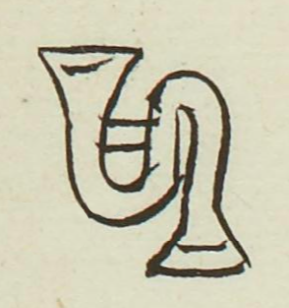Chamil (MH529r)
This black-line drawing of the simplex glyph for the personal name Chamil (attested here as a man’s name) shows a frontal view of a musical instrument that is curved in an S shape (on its side). It appears to be made of metal with a horn at one or both ends. A short, horizontal strut holds the two horns together in the middle of the instrument.
Stephanie Wood
This is what may have been admired as a serpent-shaped musical instrument, probably medieval or early modern. Juan José Batalla Rosado suggests a sacabuche or a trombón. (See his article in El Arte de Escribir (2018), p. 108.) Musical museums do have serpent-shaped instruments from the nineteenth century, such as the “bauduoin,” but this term does not come anywhere near chamil, and it would only be a later descendant of the instrument pictured in this glyph, if related at all. Nahuas did have metal bells (see the coyolli, below, with the sound scrolls coming out of it), which could be worn and heard from dancing. Another image below shows the drumming and singing that was typical of Nahua music.
The name Chamil, which may refer to a type of milpa (see our Online Nahuatl Dictionary entry for chamil) is still known in Mexico. How the glyph relates to a milpa is far from obvious. An article in the newspaper, El Sol de Tlaxcala, from October 30, 2021, mentions a Francisco Chamil Chamil in association with bell making in Rosario Ocotoxco.
Stephanie Wood
franco chamil
Francisco Chamil
Stephanie Wood
1560
Jeff Haskett-Wood
sacabuche, trombón, música, instrumentos, serpents, serpientes

chamil, a milpa planted in March (in Mexico), https://nahuatl.wired-humanities.org/content/chamil
Matrícula de Huexotzinco, folio 529r, https://www.loc.gov/resource/gdcwdl.wdl_15282/?sp=137&st=image
This manuscript is hosted by the Library of Congress and the World Digital Library; used here with the Creative Commons, “Attribution-NonCommercial-ShareAlike 3.0 License” (CC-BY-NC-SAq 3.0).







